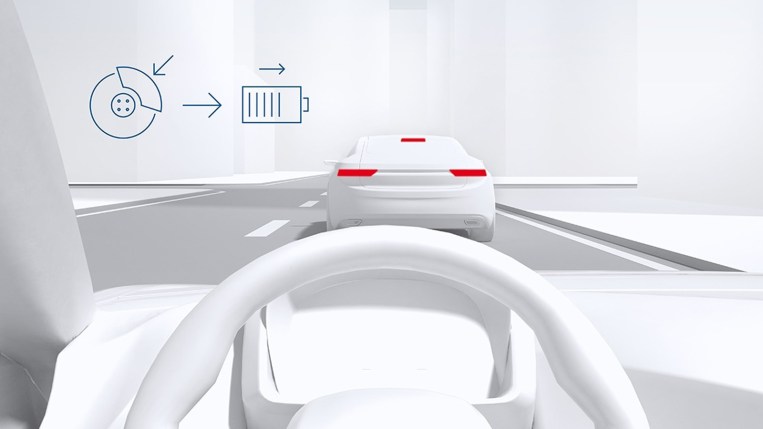Regenerative Brakes: How Do They Work? – Kelley Blue Book

If you’re shopping for a hybrid or electric vehicle, you may have heard of regenerative braking. If you’re wondering what that is and how it works, you’re in the right place.
Mục Lục
What Are Regenerative Brakes?
Regenerative brakes use electric motors rather than a traditional friction braking system to slow down and stop a car. Hybrid and electric vehicles typically use these types of brakes.
With a traditional hydraulic braking system — usually disc brakes or drum brakes — braking wastes energy. It takes the kinetic energy moving your car forward and turns it into heat rather than motion. Although it’s effective at slowing down a moving vehicle, friction braking wastes energy.
With regenerative brakes, the braking system captures that kinetic energy and transfers it into the car’s batteries. The system wastes less energy than it would with friction braking. Using regenerative brakes helps preserve and replenish range in an electric or plug-in hybrid vehicle.
In a conventional hybrid, the recovered energy from regenerative braking helps power some auxiliary functions in the car, such as the audio and climate control systems. This takes some of the load off the engine and electrical system and improves efficiency.
There’s another type of regenerative braking called Hydraulic Power Assist. It typically only applies to commercial vehicles. Electric regenerative braking is the type of system relevant to the average driver learning about regenerative brakes.
RELATED: Busting the Myths and Fears of Buying an Electric Car
Which Types of EVs Have Regenerative Brakes?
All electric and plug-in hybrid vehicles on the market today in the U.S. have a regenerative braking system. Some conventional hybrids do as well, like the Toyota Prius.
Here are some cars on the market today with regenerative brakes. This list is not comprehensive:
RELATED ARTICLES: Electric Cars 101: What You Need to Know About EVs
Pros
Recovered energy: Hydraulic brakes waste energy by turning kinetic energy into heat. However, regenerative braking feeds that energy into the car’s batteries and turns it into a little extra driving range.
Improved range: Regenerative braking doesn’t add significant miles to your driving range. Still, those gains in recaptured energy can really add up when used liberally and regularly. Hybrid and EV drivers know that every mile of battery range counts.
Reduced brake wear: The more you use regenerative brakes, the less you need to use traditional friction brakes. That means fewer trips to a service center for brake pads, rotors, and shoes. With regenerative braking, some hybrids and EVs can go around 100,000 miles between brake services.
Cons
Takes getting used to: Regenerative brakes take a little getting used to, especially if you’re shopping for a used example of an early EV or hybrid. This technology is advancing, but regenerative braking sometimes has a weird feeling that can be jarring to the driver.
Less reliable at high speeds: Friction braking is a very old technology that is very reliable. When you slam on the brakes in a car with hydraulic disc or drum brakes, the vehicle reliably comes to a stop promptly. Regenerative brakes aren’t as good as friction brakes for emergencies where the car has to come to a complete stop quickly. That’s why hybrids and EVs typically use both types of braking systems.
Low speed, low benefit: When you use regenerative braking in low-speed city driving, it doesn’t generate enough energy to make any meaningful impact on the range of your car. For that reason, using regenerative brakes in low-speed driving has little benefit.
RELATED: How Do Electric Car Tax Credits Work?
How Regenerative Brakes Work
Regenerative brakes work by reversing electric motors that propel a car. It works like a generator and feeds energy back into the hybrid or electric system to help replenish a little bit of range. These small boosts in battery range can accumulate and improve efficiency over time when used regularly.
Drivers can activate regenerative brakes in a few different ways. Some hybrid and electric cars have a paddle by the steering wheel that activates the regenerative brakes. However, activation is seamless in most cars with regenerative braking. Applying the regular brake pedal with your foot makes the regenerative and friction brakes work together to slow down the vehicle. Cars with an especially aggressive system can use regenerative brakes when the car is coasting. Sometimes called one-pedal driving, drivers may use the feature while in a specific drive mode that emphasizes efficiency on longer trips.
Although regenerative brakes use different engineering than friction brakes, it achieves the same goal of slowing down and stopping a moving car. Since it has the same effect as regular brakes, the brake lights still come on when using regenerative brakes as a safety measure.
For example, say you’re driving a Nissan Leaf in e-Pedal mode. When you lift your foot off the accelerator, the regenerative brakes activate automatically. At the same time, the brake lights on the back of the car turn on like they would if you were to depress the brake pedal.
Brake and Regenerate
Regenerative brakes are a great way to preserve the range of an EV and improve the efficiency of a hybrid. You can use them a lot to recapture a lot of energy, or you can let them work in the background without changing your driving habits. Either way, you’ll be glad your next hybrid or EV has them.















![Toni Kroos là ai? [ sự thật về tiểu sử đầy đủ Toni Kroos ]](https://evbn.org/wp-content/uploads/New-Project-6635-1671934592.jpg)


